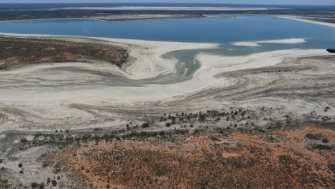
Date: Tuesday, November 17, 2015
Project: Eastern Australian Waterbird Survey
Observer: Terry Korn
Westwards today, leaving behind the rich cropping country of Moree with its diminished, stressed wetlands to the largely unregulated rivers, apart from the Darling, and floodplains to the west. Along the way we survey the Narran Lakes complex which is dry except for the eastern clay pan/cane grass sections which have filled with recent local rains. These features produce little food for water birds and thus attract small numbers. Today was no exception.
Clear Lake is dry but small patches of water persist from recent local rain. Photo: Terry Korn
The local falls have also filled cane grass swamps and generated small flows in the Bogan and Culgoa rivers which join the Darling within a few kilometres of each other, upstream of Bourke. The Darling will benefit from these small inflows. Surprisingly, the Warrego River floodplain is also adorned with patches of water, leading to the Cuttaburra Creek trickling via its feeders into the Cuttaburra Basin or Yantabulla Swamp. However, the rain appears to have dissipated by the Paroo as cane grass swamps and clay pans are dry in this area.
The Culgoa River joins the Darling River. Photo: Terry Korn
The Cuttaburra Creek channels feed the Cuttaburra Basin. Photo: Terry Korn
Lake Numalla was a carpet of birds. This fresh water lake, fed by the Paroo, is normally the poor cousin of its salty neighbour, Wyara. But Wyara is dry and Numalla is now a third of its normal size, shallow and brackish, a perfect recipe for waterbirds. Over 20,000 pink-eared ducks, 6000 grey teal, 5000 red-necked Avocets and 3500 pelicans lined the shore while swans, pied cormorants, hardhead, coot and black duck were also in good numbers. On a perfectly calm day we feverishly counted waves of birds rising like a tsunami as we skimmed the lake. Such high numbers of mixed species (20) is a huge counting challenge but it makes the effort worthwhile when you see marvellous congregations such as this.
Lake Numalla has changed to a brackish Lake, attracting many waterbirds. Dry Lake Wyara is in the background. Photo: Terry Korn
Following the Paroo south to count Lake Tongo and the Mullawoolka Basin, we noted the health of the only unregulated river in the Murray Darling Basin. Tongo and Mullawoolka are two of the many lower lakes that form part of the outstanding Paroo overflow system. They hold small amounts of water, few waterbirds were present and they will be dry within the month.
Tomorrow we survey the Macquarie Marshes, completing the 2015 survey which began on 6 October.
